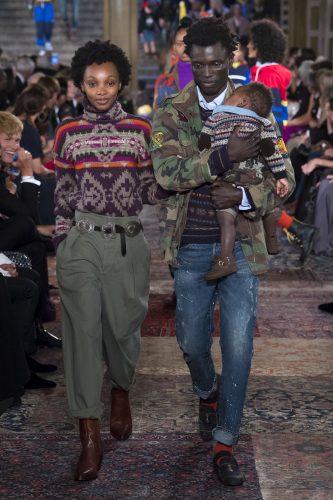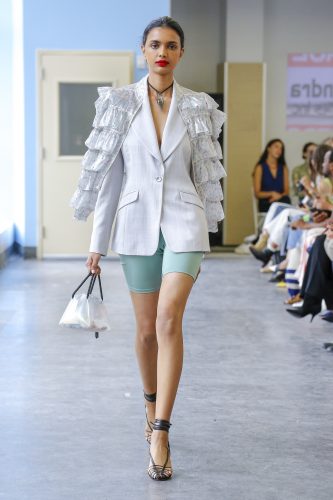AMERICANA IS HERE TO STAY
Despite growing political divides in the United States, Americana continues to be a strong trend on the runway and on New York streets. From Proenza Schouler’s bandannas and acid wash denim to army pants, camouflage and southwestern prints at Ralph Lauren, the spring/summer runways recalled the wild west. Coach 1984’s collection boasted fringed leather jackets and patchwork denim. Cowboy-inspired shirts that have been characteristic of Calvin Klein’s recent collections returned this year. Longchamp’s Americana vibe borrowed from the fringe-embellished suede-wearing hippies of the 1970s. New York fashion week continues to showcase America’s unique style.

Photo cortesy of Vouge.
DESIGNING CLOTHES…AND THE RUNWAY
It seems that designers are becoming more and more conscious of the environment in which they present their clothes. Rodarte’s show full of dreamy pastels, capes, flower hair ornaments and glimmering gowns was presented against the backdrop of a misty New York cemetery, giving the impression of a dark fairy tale. Coach 1941’s industrial and moody collection was presented in a dimly-lit warehouse, with models rotating around a giant dinosaur constructed out of salvaged metal. At the risk of distancing themselves from Manhattan-residing fashion lovers, young designers like Eckhaus Latta showed off their New York roots through their industrial and brutalist clothing lines set against white-walls and the exposed brick that is characteristic of Brooklyn. These immersive settings show that fashion has grown more conscious of the ways that wearing a piece of beautiful clothing can become a form of performance art.
THE ‘80S ARE STILL BACK
This season boasted nylon, shoulder pads, pastel suits and high-waisted trousers to the extreme. Designers have moved from the muted tones and plaid fabrics of the fall and winter pantsuits to runways filled with pastels and bright patterns in ‘80s silhouettes. There was an overwhelming trend of contemporary and feminine takes on suits on and off the runways this season. At Tibi suit jackets were layered in unique color palettes over long dresses and skirts. Tom Ford’s show was a celebration of the designer’s past but was still quite modern with its creamy leathers, crocodile prints and high shoulder pads.
PVC, pleather and all things plastic are popular trends that seemed to start last season, shown in Maryam Nassir Zadeh’s trademark clear bags. One might wonder if such trends look back to the past or represent a very current environmental critique on the United States’ obsession with plastic consumption.

Photo courtesory of Vouge.
MAXIMALIST PATTERNS AND FABRICS
While clean lines and simple linen will always be in style, this fashion week showed that designers are not afraid to play with thick and elaborate fabrics, even when designing for hot summer days. Rodarte’s show was filled with metallic, feathery and floral patterns framed with lace and beaded etchings, mimicking the silhouettes of turn-of-the-century gowns. Brock Collection mixed spring brights with thick fall fabrics and delicate flowery embroidery. Michael Kors transported the audience to the beach with its loud, tropical prints. Oscar de la Renta was a grandiose show with a color palette of jewel tones, metallic golds and multi-patterned sarongs.
CELEBRATING DIVERSITY
Fashion has notoriously been an exclusionary and white-dominated industry. However, there has been growing diversity of age and race on the runway in recent years. Designers like Gucci have been playing with diversity for the past few seasons, casting unique figures for their shows. For the past few seasons, Pyer Moss’ shows have been celebrations of black culture and black power that reflected on the clothes and the cast of models.
Despite growing diversity of style, body types on the runway have remained consistently model-thin. However, designers like Rihanna and Eckhous Latta have recently shown how a range of body types can transform a show and promote inclusivity. This year, Rihannas Savage x Fenty show was a presentation of women being unapologetically women. Her lingerie line–which was fundamentally presented at its launch to be for women of all body types–was modeled by women with baby bumps, colorful hair, DDD bra sizes and a diverse range of skin tones. These models danced across the stage with their bodies intertwined, showcasing not only the clothes, but their solidarity.
Another hopeful sign that fashion is taking a progressive turn was LA designer Marco Marco‘s show–which was the first show in history boasting an all-transgender cast of models. Hopefully, this growing sense of diversity is not merely trendy, but will cast a critical eye on the vast majority of designers who still cast the homogenous white, thin and feminine models for all of their shows.
WHO TO WATCH FOR NEXT WEEK IN PARIS:
Chloe, Loewe, Chanel, Stella McCartney, Celine, Balenciaga and Valentino.
Cover photos courtesy of Vogue.

Whatta country!